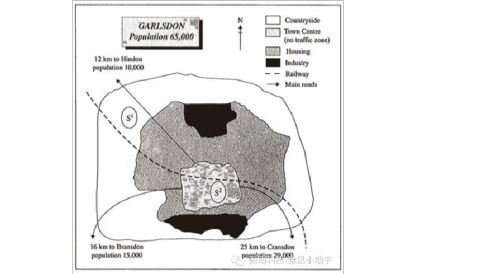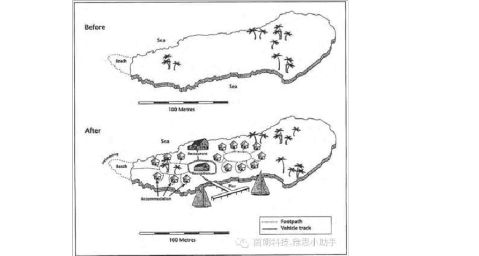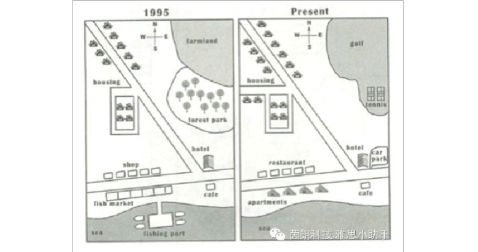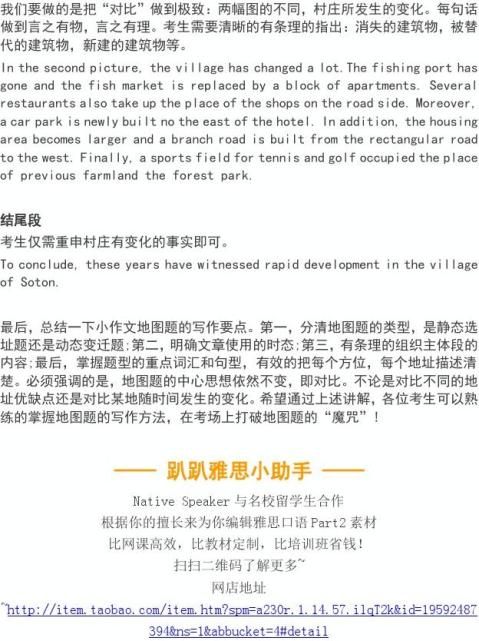雅思作文地图题词汇
雅思作文地图题词汇
——by 刘利强
描写方位的词汇
E.g be in close to ...;be in near to...;be in proximity of...;On the left of...;in the left-hand corner of...;
be halfway between...and ...; exactly in the middle of...;be at the bottom of...
小结:in 表A在B内,at表A在B外,on表A和B连接,to 表A和B分开。 描写地理方位的句型。雅词词汇
A is situated/located/built in...
A is /lies/is located/is situated in/on/to the north of B
A is in the eastern part of B
A lies 120km to the northwest of B
A is on the opposite side of B/A is opposite B.
At the southern end of the river
The area adjacent to/near/next to/just off the road
描写地理变化的常用词汇 原有事物 the original /previous/former....(garden,forest,river,ect) 原有事物消失 the ...completely disappeared/were removed. 原有事物被改变为A is transformed /reconstructed/redeveloped/converted /changed/turn over to/into B
增加了新事物
The year 2000 saw two additions to the land :a pond in the northern part and a vegetable garden on the opposite side.
事物增长了几倍
The number of ... has doubled/tripled/quadrupled to ...
事物大小变化 The size of the ..has been enlarged /extended/halved/reduced by half 描写变化常用的句型 如:现在停车场改成了一个剧院. The car park has been removed and replaced by a theatre.
总结:描写变化的基本原则是地图每个细节都要提到,不要忽视细节。
要注意描写变化的书写顺序,一般分为时间顺序和空间顺序。To
注意文章的时态,如果地图题反映的是一个地方过去的一段时间的变化,则文章用一般过去时。如果地图题反映的是一个地方将来一段时间的变化趋势,则文章用一般将来时或表“估计”的词汇。如果地图题反映的是一个地方从过去到现在的变化,可用现在完成时。
二、How to describe maps.
地图题只考查两个类型,一个是选址类考题,要根据地理位置的描述来择优选择建设方案。这类题写法上往往先介绍图片上事物所处的位置,接着说明影响方案选择的因素,如涉及空间、交通和环境,最后确定哪个方案最好。另一类地图题是某个区域内,某个事物不同年代的变化情况。
be far from 距离某处很远
be near 距离某处很近 be next to 紧邻 be in the vicinity of 邻近 be adjacent to 邻近 be located behind/in front of 坐落在的前面/后面 be on one’s left/right 在某人的左边/右边 turn left/right 左转/右转 go along 沿着一直走 go up/down 向上/向下 go straight across the yard 径直穿过院子 go back/back up 向回走 go east/west/south/north 向东/西/南/北 be the first from the left 从左数第一个 be on the corner of A street and B street 在A和B街角处 ground floor 一层 wing/annex 翼楼/配楼 intersection/crossroad 十字路口 T-junction 丁字路口 pavement/sidewalk 人行道 zebra crossing/pedestrian crossing 斑马线
空间表达时需要注意区分:在空间状语里,in 表内部,on 表接壤,to 表分开。常用的空间词: lies 靠近 is located 坐落 is situated in 位于 across 交叉 parallel 平行 intersect 交点 near/next to/close to/adjacent to 靠近 on the ?side of the ?面 on both sides of 两边 just off ?靠近 on the opposite side 在另一边 on the border 在边缘上 center/middle/central area 中间例句:It lies 450 kilometers from the nearest city, which is on the north side of the KK mountain. Part 3:表顺序表顺序的使用在流程图中是典型,表顺序的关联词能够使描述的流程更加清晰,结构条理明显。就如我们常用的产品安装说明一样,标明了 1、2、3、4 步,简洁明了。常见的表顺序的连词如下:开始:first of all, initially, to begin with, in the first place, first, the first stage involves ?, during, in the first place 其次: second, then, next, also, in the second stage, following this/that, afterwards the first (reason) is 然后:after that, at the same time, in the meantime, meanwhile, prior to, until, in the third stage, in addition, at the same time, from that moment on, once when 最终:finally, lastly, in the final stage, in the end 例句:First the fruit is picked from trees by hand. It is then transported to the cannery by large trucks. Part 4:表动作动词部分应当是流程和地图题的重点,这里要做一个明确的区分:流程图的动作以流程步骤中的操作动作为主,而地图题中的动作以地理位置变迁的变化动词为主。
词汇分成两大部分:
A. 流程动词:细节动作: lay, put 放 strike 打 compress 压缩 release 释放 move, flow 流动 press 按压 adjust 调整 rotate 旋转 chop 砍 grind 磨碎 light 点燃 burn 燃烧 ignite 点燃 reflect 反光 turn up 调高 turn down 调低 wind 缠绕 unwind 解开 revolve 旋转 unfold 打开 reverse 颠倒,倒转 heat up 加热 expand 膨胀 bend 弯曲 spin 旋转
absorb 吸收 evaporate 蒸发 volatilize 挥发 draw 提取 poured into 倒入变化: accumulate 积累 gather/collect 收集 obtain 获得 turn off 关闭 cool down 冷却 disconnect 断开连接 renovate 革新,更新,修复 process 加工 fade 褪色 increase 增长 promote 促进;升职 reduce 减少 renew 使更新,使恢复 convey 运送 replace 取代 shrink 收缩 melt 溶解 heal 治愈 recycle 回收组成: be made up of 由...组成 be made of 由...制成 separate 分开
B. 地图变化词 be made from 由...制成 feed on 以...为食 depend on/rely on 依赖 sort 分类变大: enlarged extended doubled, tripled increased soar by half risen 变小: dropped reduced decreased grown fallen halved 消失:disappeared removed no more here 建成: becomes transformed reconstructed redeveloped converted into added to the library changed into turned over to replaced /substituted gives way to ? newly-built built establish set up constructed completed and opened 例句: 1. Uranium is found under the ground and so it must be mined. Once the mined uranium has been extracted, it is taken to a processing centre. 2. A new IT centre has been added to the library.
第二篇:雅思作文趴趴讲之我们为什么要恐惧地图题?
雅思作文趴趴讲之我们为什么要恐惧地图题?

变迁题很多准备考雅思的同学对雅思写作地图题非常恐惧,不知道该如何下手,今天就给大家讲解雅思写作地图题怎么写,希望对大家有所帮助。
一、分清类型:静态选址OR动态变迁?
分析近几年IELTSWriting出现过的地图题,我们可以把地图题分为两大类:一类,静态选址题;一类,动态变迁题。
静态选址题,这种题型要求考生对建筑物不同地址的利弊进行比较,多数静态选址题是在两个地址之间的比较,多于两个地址之间的比较会出现的较少。例1:剑桥5的Test3
动态变迁题,这类题型要求考生对某个地理区域在不同历史年代里的情况进行比较。
例2:

二、静态选址题的解题技巧
1.时态
解决小作文,我们首要的一个步骤就是明确全文要用的时态。一般而言,静态选址类的题目当中如果没有明确表示过去时间点的标识词,使用一般现在时或是用would/could/might等表示假设的虚拟语气形式。
2.主体段
建议各位考生按照不同的地址来划分主体段,需要比较几处地址就分成几个主体段,然后具体去写每个地址的利与弊。
3.开头和结尾
静态选址的开头和数据类图型一样改写题目就可以,结尾只需要说明不同地址各自都有优缺点,可以不去选择一个较好的地址。
4.重点词汇和句型
在地图题当中,考生必须熟练掌握词汇和句型:
(1)方位词
东east东北north-east
西west东南south-east
北north西北north-west
南south西南north-west
(2)坐落/位于
Aislocated…
Aissituated…
Alies…
(3)介词的使用
A在B内的东部
AislocatedintheeastsideofB
(4)A在距离B东部.。。的公里
Aislocated…kilometerstotheeastofB
(5)A在B的东部角落
AislocatedattheeastcornerofB
(6)A在B的东部边缘
AislocatedontheeastedgeofB
(7)紧邻/对面/朝向
Aisnextto/iscloseto/isadjacentto/AisintheproximitytoBAisoppositeB
Afaceseast/Afacestowardstheeast
(8)沿着河流/道路
alongwithriver/road
alongsidetheriver/road
(9)道路通向/河流流向
Theroad/riverrunsfrom…to…
5.例文讲解(例1,C5-3)
通过基础词汇和句型的讲解,我们以地址s1为例,描述出s1的准确位置,同时客观分析s1作为建立超市地址的优缺点。
Thefirstpotentiallocationisoutsidethetownitselfand
issitedjustoffthemainroadtothetownofHindon,lying12kmstothenorth-west.Thissiteisinthecountrysideandsowouldbeabletoaccommodatealotofcarparking.Thiswouldmakeitaccessible
toshoppersfrombothHindonandGarlsonwhocouldtravelbycar.AsitisalsoclosetotherailwaylinelinkingthetwotownstoCransdon(25kmtothesouth-east),apotentiallylargenumberofshopperswouldalsobeabletotravelbytrain。
三、动态变迁题的解题技巧
1.时态
动态变迁题的开头段改写原题用一般现在时,主体段根据图形来决定。如果题目当中有明确表示过去和现在时间标志的词,我们按照图形使用不同的时态。如图所示,例3:Themapsshowthechangesofasmallvillagefrom1995topresent.

很显然,在描述第一幅图,有明确的过去时标识词,1995,我们使用一般过去时;在描述第二幅图,存在明确的现在时标识词,present,使用一般现在时。
2.主体段落
开头段即改写原题,结尾段概括某个地理区域是如何发展变化的。
动态选址题通常按照时间顺序划分主体段。题目出现几个年代就分成几个主体段来写,每段写其中一个历史阶段,具体描述两个年代的变化和不同之处。如果有多个年代变化阶段,可以考虑把合并变化阶段来写主体段。
3.重点词汇和句型
动态变迁题,除了需要掌握上述静态选址题当中表述方位,位置,朝向等重点词汇之外,还需要掌握以下词汇,
(1)某处兴建了A
Aisbuiltin
Aiscontractedin
Aisestablishedin
(2)某处增建了A
Aisaddedto…
Anadditionismadeto…,whichisA
(3)A被B替代/A改造成B
Aisturnedinto/istransformedintoB
AisconvertedintoB
(4)A被搬走
Aisremoved/demolishedfrom…
(5)A的面积缩小了/A的面积扩大了
ThesizeofAisreducedto(onlyhalfof/onethirdoftheoriginalsize)Aisexpanded(totwiceitssize)=ThesizeofAalmostdoubled.
(6)A向…方向延长
Aextends(eastward/westward/southward…)
4.例文讲解(例3)
开头同数据型图标文章一样,对题目做简单的改写:Themapsrevealthe
alterationsofthevillageofSotonovertheperiodfrom1995topresent。主体段
首先,我们需要对第一幅图片进行细节的描述。从总体上说,村庄被分成了两部分。按照从南到北的角度,去描述村庄里面具体存在的建筑物。
Inthefirstpicture,thevillagewasdividedintothreepartsbytwomajorroads.Inthesouthernpart,therewasafishingportonthesea,andafishmarket,whichwasneartheport,wasjustlocatedatthesouthsideofthemajorroad.Oppositetothemarket,therewasablockofshopssittingontheothersideoftheroad.Eastoftheshops,ahotelandacafewerebuiltatthejointofthetwomajorroads.Thenorthwestpartwasbasicallyaresidentialarea,andsomeofthehousesweresurroundedbyarectangularroad.Inaddition,afarmlandofgreatacreageoccupiedthenortheastcorner,whileaforestparkofsimilarsizewasestablishedonthesouthofthefarmland.
第二段


-
雅思小作文地图题详解
小作文地图题分两种一种为地理变迁题一种为选址题首先我们来看地理变迁题它描述的是一个地方多为一个城镇在一段时间的发展变化如20xx年…
-
雅思小作文地图题的写法
地图题的写法目前我们见到或听到的地图题主要是两种1描述地区的变化2描述一个具体的位置我觉得地图题最好的补充资料就是听力题里面的地图…
-
雅思小作文——地图题
地图题分两种一种为地理变迁题一种为选址题首先我们来看地理变迁题它描述的是一个地方多为一个城镇在一段时间的发展变化如20xx年9月A…
-
雅思写作邂逅地图题:Take it easy
新航道官网雅思写作邂逅地图题Takeiteasy地图题写作有别于数据图构思方面没有数据图那么复杂只需按照方位合理描写即可但在语言驾…
-
雅思小作文地图题
雅思小作文题型多样其中就包括地图题本文将详细讲解雅思小作文地图题写作技巧评分标准TATaskAchievement任务完成情况CC…
-
雅思小作文地图题
雅思小作文题型多样其中就包括地图题本文将详细讲解雅思小作文地图题写作技巧评分标准TATaskAchievement任务完成情况CC…
-
雅思小作文流程地图题词汇锦囊
雅思培训托福培训雅思小作文流程地图题词汇朗阁雅思培训中心在雅思写作部分A类小作文的流程图和地图题一直是烤鸭们比较头痛的部分此部分题…
-
常用的雅思小作文流程图和地图题词汇
雅思小作文流程图和地图题词汇在雅思写作部分A类小作文的流程图和地图题一直是雅思烤鸭们比较头痛的部分此部分题型在构文方式并没有特别的…
-
朗阁20xx14_雅思小作文流程地图题词汇锦囊
朗阁20xx14雅思小作文流程地图题词汇锦囊朗阁海外考试研究中心在雅思写作部分A类小作文的流程图和地图题一直是烤鸭们比较头痛的部分…
-
雅思写作地图题写作技巧
地图题写作在很多书上都没有系统的指导它有别于数据图构思方面没有数据图那么复杂但在语言驾驭很多学生都感到很陌生怎么写地图题将在下文中…
-
20xx年雅思笔试写作真题回忆汇总从1月到12月
20xx年1月8日Task12pies要求考生描述不同学历的人的就业的情况Task2Somepeoplebelievethatro…